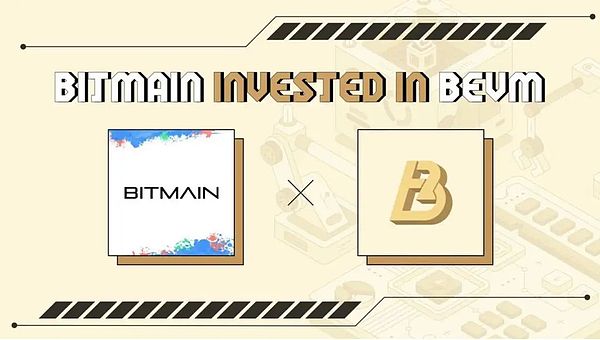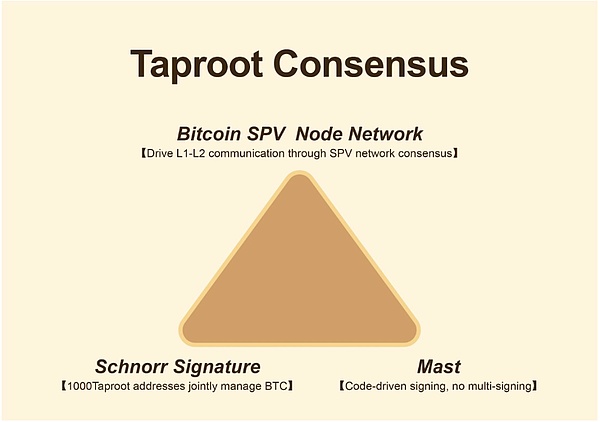Recently, the BTC Layer2 project named BEVM announced that it had received investment from Bitmain, with a post-investment valuation of 200 million US dollars. The financing news has attracted considerable attention.

The focus is not on valuation, but on the investor Bitmain. Since its birth in 2013, Bitmain has been dominating the global Bitcoin mining machine market with the world's leading Bitcoin mining machine research and development technology. Not only is its mining machine business the world's number one, but its mining farms and mining pool businesses have an absolute influence on the global Bitcoin miner community.
Since 2023, the popularity of Bitcoin inscriptions has stimulated the rapid development of the Bitcoin ecosystem, and some Bitcoin application projects and Layer2 projects that expand Bitcoin performance have emerged in an endless stream. However, under the premise that the Bitcoin ecosystem is very beneficial to the miners, there is still a lack of leaders in the mining ecosystem like Bitmain.
Previously, many people thought that institutions like Bitmain would not be interested in the Bitcoin ecosystem, but this time Bitmain's decisive move dispelled everyone's doubts.
Not only that, after BEVM went online on the mainnet, it launched an on-chain airdrop activity with the Binance Web3 wallet. BEVM is also the first BTC Layer2 project to be connected to the mainnet by Binance Web3.
So, as an investment by Bitmain and the first BTC Layer2 project connected by Binance, what are the highlights and advantages of BEVM, which can stand out from a number of BTC Layer2 projects and obtain the support of two top institutions in the two major tracks of Crypto?
What is Taproot Consensus?
The author believes that whether it is Bitmain Investment or Binance, before making such a strong support, the priority must be the security of the project, the technological innovation, and the long-term value and impact on its own brand. For a BTC Layer2 project, its technical foundation is the foundation of everything.
Before understanding BEVM, we need to know an important concept about Bitcoin Layer2-Taproot Consensus. What is this "BTC Layer2 solution that is comparable to Rollup" called by the industry, and why has it received great attention from the Bitcoin community?
Taproot Consensus was first proposed by the BEVM team in 2021 as a fully decentralized BTC Layer2 solution based on the Bitcoin Taproot upgrade.
Taproot Consensus=
Schnorr Signature+MAST+Bitcoin SPV Node Network, let's disassemble them one by one below.
Schnorr Signature
Schnorr Signature is the digital signature algorithm introduced by Bitcoin's Taproot upgrade in 2021. Compared with the elliptic curve signature, the advantage of Schnorr Signature is that Schnorr Signature can expand Bitcoin's multi-signature address to 1,000, that is, 1,000 Taproot wallet addresses can jointly manage the same BTC assets, and it can ensure efficiency, security and privacy. The traditional Bitcoin multi-signature based on elliptic curve signature has a maximum upper limit of only 15 addresses, while Schnorr Signature can achieve sufficient decentralization of multi-signature addresses.
However, it is not enough to simply achieve the decentralization of multi-signature addresses. The signature must also be automated and intelligent, that is, it must be code-driven, not relying on people to sign.
Imagine, if a BTC L2, whose custodial Bitcoin address still needs a group of people to sign one by one to execute the entry and exit, how low is its efficiency? How can its security be guaranteed?
Therefore, after achieving the decentralization of multi-signature addresses, MAST must be introduced to achieve the automation and coding of signatures.
MAST is also one of the core technologies introduced by the Bitcoin Taproot upgrade. MAST stands for Merkle Abstract Syntax Tree, which uses Merkle trees to encrypt complex locking scripts, and its leaves are a series of non-overlapping scripts (for example, multi-signatures or time locks). When spending, only the relevant scripts and the path from the script to the Merkle tree root need to be disclosed. It can be simply understood that MAST is a "smart contract" that runs on the Bitcoin chain and can handle multi-signature payments (although it is different from Ethereum's smart contract, it can play the role of a smart contract when applied to Bitcoin Schnorr multi-signature)
With MAST, the intelligence, automation, and coding of Schnorr signatures can be realized, that is, the concept of "multi-signers" is eliminated here, and replaced by code instructions. This is a very important point.
So, who will issue the instructions?
The Bitcoin SPV Node Network (Bitcoin light node network) issues the instructions.
That is, the network composed of Bitcoin light nodes running on the BTC second-layer network relies on the BFT network consensus to drive MAST to issue instructions, not driven by any organization or person, which achieves complete decentralization.
Why use Bitcoin SPV Node Network instead of ordinary POS node network? Because Bitcoin light nodes can synchronize Bitcoin layer data, and can also verify payments conveniently and securely without complete transaction records, that is, to achieve SPV (Simplified Payment Verification, abbreviated as SPV, which is a simple payment verification scheme proposed by Satoshi Nakamoto in the Bitcoin white paper).
Therefore, we can summarize:

Schnorr Signature allows Bitcoin multi-signature addresses to be expanded to 1,000, realizing the decentralization of multi-signature addresses.
MAST realizes the coding of multi-signature management, which does not rely on people to sign, but relies on code-driven.
Bitcoin Light Node Network realizes multi-signature driven by Bitcoin Light Node Network consensus, and fully realizes decentralized Bitcoin cross-chain and management.
And Schnorr Signature+MAST+Bitcoin SPV Node Network jointly builds a completely decentralized BTC Layer2 solution - Taproot Consensus.
Why has BEVM become a BTC L2 worthy of attention?
On the other hand, Taproot Consensus was proposed by the BEVM team, and BEVM is the first BTC Layer2 use case of Taproot Consensus.
The most rare thing is that Taproot Consensus is a second-layer solution built entirely on Bitcoin's native technology. It does not introduce any technology other than Bitcoin, nor does it make any changes to the Bitcoin code. Instead, it is a culmination of the three native technologies of Bitcoin: Schnorr Signature, MAST, and Bitcoin SPV Node Network.
It can be said that this is the most native and decentralized BTC L2 solution at present, so it is described by the community as a Bitcoin second-layer solution that can be compared with Ethereum's second-layer Rollup.
On the other hand, most of the other Bitcoin second-layer solutions on the market are copied from Ethereum's second-layer solutions. For example, the scheme of forcibly introducing ZK-Rollup to Bitcoin. First of all, Bitcoin miners only verify data related to Bitcoin transactions, and will not and cannot verify other data such as ZKP. Since Bitcoin Rollup cannot obtain the security of Bitcoin Layer 1 like Ethereum Rollup, then, whether it is ZK-Rollup or OP-Rollup, it has no meaning for Bitcoin Layer 2. This is a completely copycat and perfunctory solution without any professionalism and rigor.
Of course, there are so-called Layer 2 solutions like RGB and BitVM that seem clear. However, RGB and BitVM are still just trying to make more expansions in Bitcoin's limited block space and minimalist UTXO model. This is not only contrary to the purity of Bitcoin, but also difficult to truly realize Bitcoin's Layer 2 expansion. After all, based on UTXO, only simple asset issuance can be done. To achieve greater scalability of Bitcoin, Bitcoin must be jumped to the second layer in a trustless way to realize the expansion of application scenarios.
At present, the Taproot Consensus Bitcoin second-layer solution proposed by BEVM not only completely inherits the native technology of Bitcoin, but also allows Bitcoin to jump to the second layer in a completely decentralized way without destroying any Bitcoin code and consensus, to achieve unlimited scalability. This is a Bitcoin second-layer solution that truly combines native innovation and practical implementation.
After all, only by achieving decentralization and trustlessness can the problem of BTC Layer2 asset security be solved. Only by solving the problem of asset security can the on-chain ecology and application of Bitcoin be steadily and permanently built.
And safe and sustainable long-term development may be the most important criteria for leading institutions such as Bitmain and Binance to choose to support ecological projects. Undoubtedly, BEVM just meets these principles.
The author believes that this is the only answer for BEVM to stand out from many BTC Layer2.
Because, mid-level institutions choose to grow quickly, while top institutions choose to grow steadily and for a long time, which is an unchanging rule in any field.
 JinseFinance
JinseFinance






